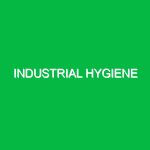In the realm of Health, Safety, and Environment (HSE), understanding and managing risks is paramount. Among the many frameworks and methodologies, exposure assessment and control stands out as a critical component. This process involves evaluating the likelihood and severity of exposure to various hazards and implementing strategies to mitigate risks. As workplaces evolve and new challenges emerge, the significance of effective exposure assessment and control becomes increasingly evident.
Understanding Exposure Assessment and Control
Exposure assessment refers to the systematic approach used to determine the nature and extent of exposure to hazardous agents, whether physical, chemical, biological, or ergonomic. Control, on the other hand, involves the application of strategies to limit or eliminate these exposures. Together, they form the backbone of a robust safety program in any organization.
Imagine walking into a manufacturing facility where machinery hums and raw materials abound. Each aspect of this environment can pose risks. For instance, workers might be exposed to harmful chemicals, loud noises, or repetitive motion injuries. Exposure assessment helps identify these hazards, while control measures—like personal protective equipment (PPE), engineering controls, or administrative changes—aim to protect workers. This dual approach is essential not just for compliance, but for fostering a culture of safety and well-being.
The Importance of Exposure Assessment and Control in HSE
At its core, effective exposure assessment and control leads to a safer workplace. It helps organizations comply with regulations, reduces the likelihood of accidents, and ultimately protects the health of employees. Moreover, it can enhance productivity and morale. When workers feel safe, they are more engaged and efficient.
Consider the case of a chemical manufacturing plant that implemented a thorough exposure assessment program. By identifying potential exposures to toxic substances, the management could invest in appropriate ventilation systems and PPE. This proactive approach not only reduced illness rates but also improved overall productivity. Employees reported feeling more secure, which in turn led to lower turnover rates. Such real-world examples underscore the importance of integrating exposure assessment and control into HSE strategies.
Identifying Hazards and Risks
Before implementing effective control measures, it’s essential to identify potential hazards associated with exposure. These can be broadly categorized into several types:
Chemical Hazards
Chemical hazards encompass substances that can cause harm through inhalation, skin contact, or ingestion. Common examples include solvents, heavy metals, and pesticides. For instance, in an agricultural setting, workers may be exposed to pesticides that, if not properly managed, can lead to serious health issues. Regular monitoring and proper labeling of chemicals are vital steps in minimizing risk.
Physical Hazards
Physical hazards include noise, radiation, temperature extremes, and vibration. For example, workers in construction are often exposed to high noise levels, which can lead to hearing loss over time. The implementation of noise-reducing equipment and regular hearing tests can mitigate this risk.
Biological Hazards
Biological hazards involve exposure to bacteria, viruses, fungi, or other pathogens. Healthcare workers frequently face this risk. Proper training in infection control and the use of PPE, such as masks and gloves, are critical to safeguarding health.
Ergonomic Hazards
Ergonomic hazards arise from poor workstation design or repetitive tasks, leading to musculoskeletal disorders. For instance, office workers may develop chronic back pain due to inadequate seating or desk height. Conducting ergonomic assessments and promoting proper posture can significantly reduce these risks.
Implementing Safety Precautions and Best Practices
Once hazards are identified, the next step is to implement effective safety precautions. Here are some best practices related to exposure assessment and control:
1. Conduct Regular Risk Assessments
Routine evaluations of the workplace can help identify new hazards as operations change. Engage employees in these assessments; they often have insights into potential risks that management may overlook.
2. Use Personal Protective Equipment (PPE)
PPE serves as the last line of defense against exposure. Ensure that all employees are adequately trained on the correct use of PPE and that it is readily available. Regular inspections of PPE are also vital to ensure its effectiveness.
3. Implement Engineering Controls
Engineering controls involve modifying the workplace or equipment to reduce exposure. For instance, installing ventilation systems can effectively control airborne contaminants. Maintenance of machinery to prevent leaks and spills is equally important.
4. Develop Administrative Controls
Administrative controls refer to policies and procedures that limit exposure. This can include job rotation, which minimizes the time any single worker spends in a hazardous environment. Training programs that educate employees about potential hazards and safe practices are also essential.
5. Foster a Safety Culture
Encouraging open communication about safety concerns empowers employees and fosters a culture of safety. Regular safety meetings and feedback mechanisms can help identify areas for improvement. When employees feel their voices are heard, they are more likely to engage in safe practices.
Regulations and Standards Governing Exposure Assessment and Control
Compliance with regulations is not only a legal obligation but also a fundamental aspect of exposure assessment and control. Several key regulations govern workplace safety:
Occupational Safety and Health Administration (OSHA)
In the United States, OSHA sets and enforces standards to ensure safe working conditions. Their regulations require employers to assess and control exposure to hazardous substances, providing guidelines on permissible exposure limits (PELs).
Environmental Protection Agency (EPA)
The EPA regulates hazardous waste management and air quality standards. Their guidelines often intersect with workplace safety, particularly in industries dealing with chemicals. Compliance with these regulations is crucial for both employee safety and environmental protection.
International Standards Organization (ISO)
ISO standards, such as ISO 45001, provide frameworks for occupational health and safety management systems. Implementing these standards can enhance an organization’s approach to risk management and continuous improvement.
Conclusion
Exposure assessment and control are vital components of the Health, Safety, and Environment landscape. By understanding potential hazards and implementing effective control measures, organizations can protect their workforce and enhance operational efficiency. The importance of this process cannot be overstated; it not only ensures compliance with regulations but also cultivates a culture of safety that benefits everyone involved.
As industries continue to evolve, the commitment to rigorous exposure assessment and control will remain a fundamental principle of effective HSE management. By staying proactive and engaged, organizations can navigate the complexities of workplace safety and foster environments where employees thrive.


